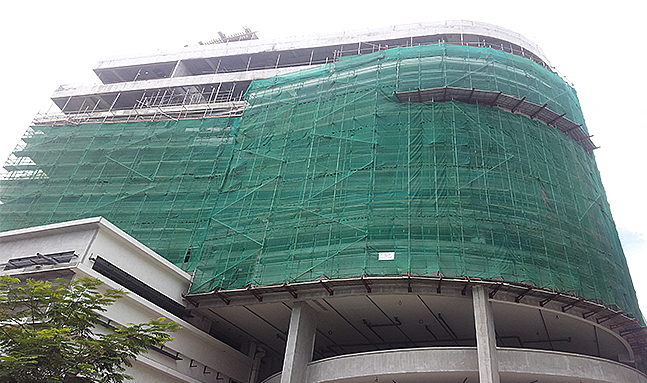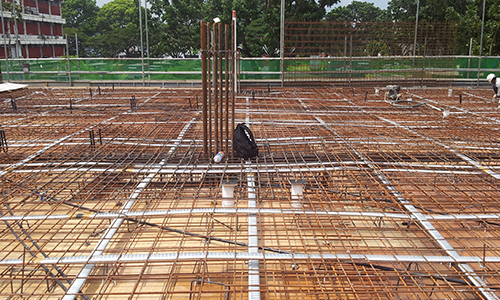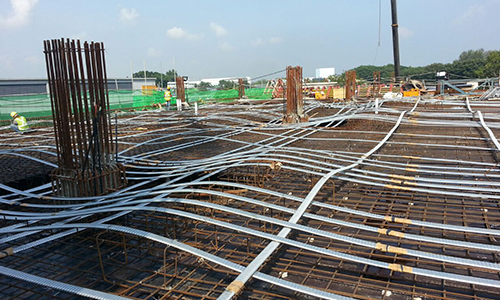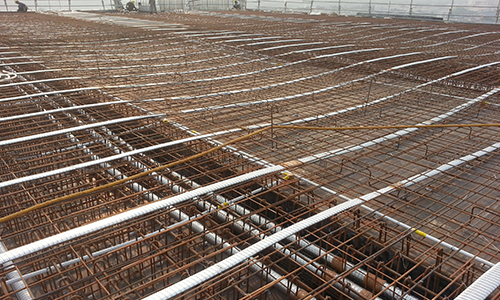


PT slabs offer the thinnest slab type, as concrete is worked to its strengths, mostly being kept in compression. Longer spans can be achieved due to prestress, which can be used to counteract deflections. Post-tensioned slabs use high strength tensioned steel strands to compress the slabs, keeping the majority of the concrete in compression. This gives a very efficient structure which minimises material usages and decreases the economic span range when compared to reinforced concrete.
The three most common floor systems used for building structures such as offices, shopping centres ,carparks & factory buildings are the flat plate, flat slab and banded slab. For high rise construction a fourth system is widely used which consists of band beams at relatively close spacing spanning from the building perimeter to the service core.

This system is commonly used for high rise building construction where the span is usually 7 to 8 metres. The most attractive feature of this floor system is its flush soffit which requires simple formwork and greatly simplifies construction.

A widely used system today for many reasons - flat soffit, simple formwork and ease of construction, as well as flexibility for locating services.

This system is used for structures where spans in one direction are predominant. It is also a very common system due to minimum material costs as well as relatively simple formwork. In most circumstances the width of the band beam is chosen to suit the standard sizes of the formwork. The sides of the band can be either square, or tapered for a more attractive result.
The band beam has a relatively wide, shallow cross section which reduces the overall depth of the floor while permitting longer spans. This concrete section simplifies the formwork and permits services to easily pass under the beams. The post-tensioned tendons are not interwoven leading to fast installation and decreased cycle time.
Post-tensioned concrete slabs in buildings have many advantages over reinforced concrete slabs and other structural systems for both single and multi-level structures. Some of the main advantages are described below.
Longer spans can be used reducing the number of columns. This results in larger, column free floor areas which greatly increase the flexibility of use for the structure and can result in higher rental returns.
The total cost of materials, labour and formwork required to construct a floor is reduced for spans greater than 7 metres, thereby providing superior economy.
For the same imposed load, thinner slabs can be used. The reduced section depths allow minimum building height with resultant savings in facade costs. Alternatively, for taller buildings it can allow more floors to be constructed within the original building envelope.
Undesirable deflections under service loads can be virtually eliminated.
Post-tensioned slabs can be designed to be crack free and therefore waterproof slabs are possible. Achievement of this objective depends upon careful design, detailing and construction. The choice of concrete mix and curing methods along with quality workmanship also play a key role.
The earlier stripping of formwork and reduced backpropping requirements enable faster construction cycles and quick re-use of formwork. This increase in speed of construction is explained further in the next section on economics.
The reduced material quantities in concrete and reinforcement greatly benefit on-site cranage requirements. The strength of post-tensioning strand is approximately 4 times that of conventional reinforcement . Therefore the total weight of reinforcing material is greatly reduced.
The reduced floor dead loads may be utilised in more economical design of the reinforced concrete columns and footings. In multi-storey buildings, reduced column sizes may increase the floor net lettable area.